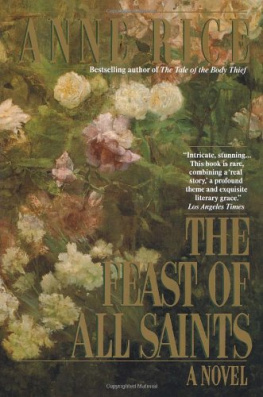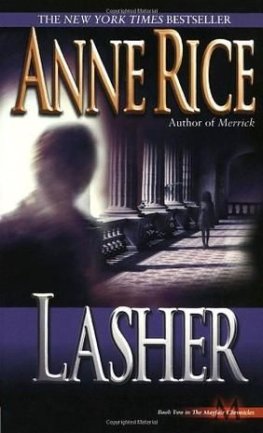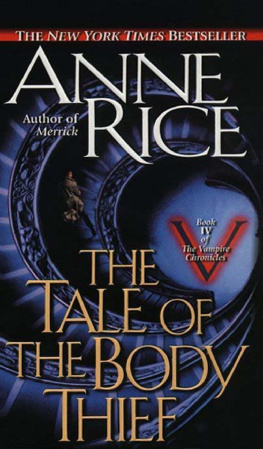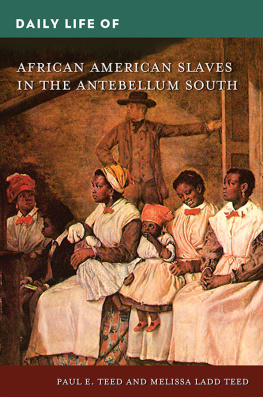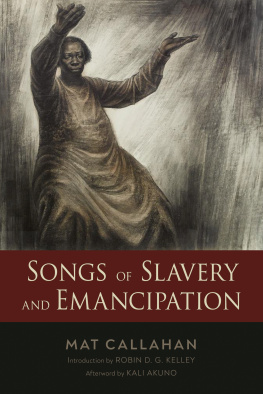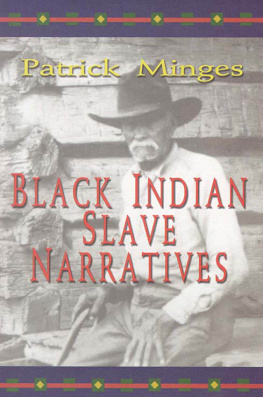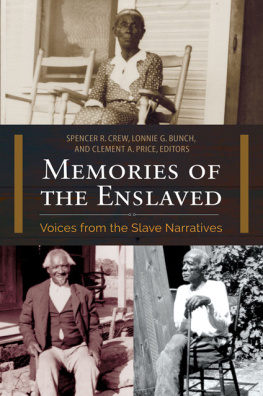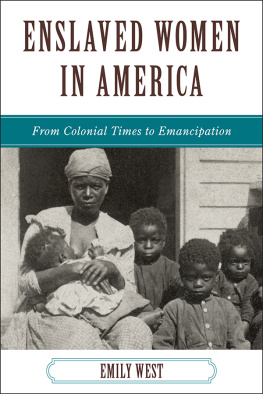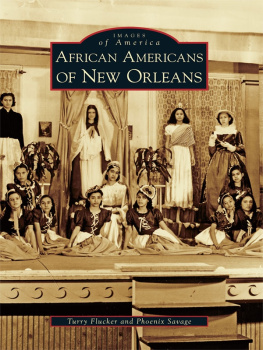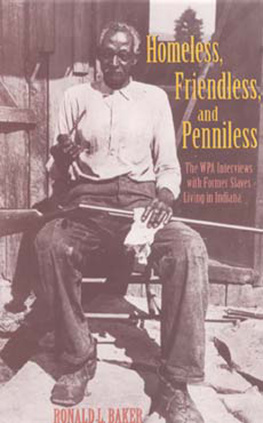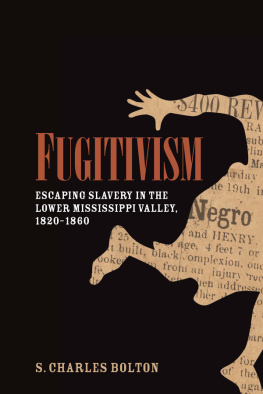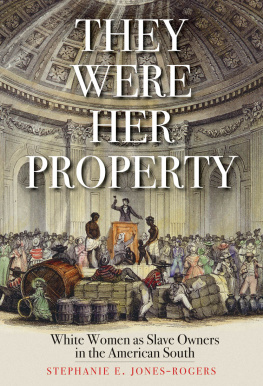Anne Rice - The feast of All Saints
Here you can read online Anne Rice - The feast of All Saints full text of the book (entire story) in english for free. Download pdf and epub, get meaning, cover and reviews about this ebook. year: 1986, publisher: Ballantine Books, genre: Art. Description of the work, (preface) as well as reviews are available. Best literature library LitArk.com created for fans of good reading and offers a wide selection of genres:
Romance novel
Science fiction
Adventure
Detective
Science
History
Home and family
Prose
Art
Politics
Computer
Non-fiction
Religion
Business
Children
Humor
Choose a favorite category and find really read worthwhile books. Enjoy immersion in the world of imagination, feel the emotions of the characters or learn something new for yourself, make an fascinating discovery.
The feast of All Saints: summary, description and annotation
We offer to read an annotation, description, summary or preface (depends on what the author of the book "The feast of All Saints" wrote himself). If you haven't found the necessary information about the book — write in the comments, we will try to find it.
The feast of All Saints — read online for free the complete book (whole text) full work
Below is the text of the book, divided by pages. System saving the place of the last page read, allows you to conveniently read the book "The feast of All Saints" online for free, without having to search again every time where you left off. Put a bookmark, and you can go to the page where you finished reading at any time.
Font size:
Interval:
Bookmark:
BY ANNE RICE
Interview with the Vampire
The Feast of All Saints
Cry to Heaven
The Vampire Lestat
The Queen of the Damned
The Mummy
The Witching Hour
The Tale of the Body Thief
Lasher
Taltos
Memnoch the Devil
Servant of the Bones
Violin
Pandora
The Vampire Armand
Vittorio, The Vampire
Merrick
Blood and Gold
Blackwood Farm
Blood Canticle
Christ the Lord: Out of Egypt
Christ the Lord: Road to Cana
Called Out of Darkness: A Spiritual Confession
Angel Time
The Feast of All Saints is a work of fiction, but certain real people are mentioned in the book, among them the quardoon fencing master, Basile Crockere; the mulatto Daguerreotypist, Jules Lion; the colored inventor, Norbert Rillieux; and the Metoyer Family of the Cane River, including Grandpre Augustin who built the church of St. Augustine which exists on Isle Brevelle today. The African house described in the novel stands on the Melrose Plantation which was called Yucca at the time this story takes place.
LAlbum Littraire, the quarterly of prose and poetry by men of color, probably commenced publication in 1843, not 1842 as the novel suggests.
But aside from a few liberties with dates, every effort has been made to render the world of New Orleans Free People of Color accurately. And the occupations of real men and women of color provided the inspiration for the purely fictional characters in the book.
Therefore, I am deeply indebted to many who have written about New Orleans and the Free People of Color in the ante-bellum South, from the popular writers who have kept alive the romance and richness of those days to the scholars whose books, articles, theses and dissertations continue to swell the growing body of work on the free Afro-American before the Civil War.
But above all, I am indebted to the gens de couleur themselves who left us painting, sculpture, music and literatureto Armand Lanusse, poet, editor and teacher, for his work with LAlbum Littraire and the later anthology, Les Cenelles; and to R.L. Desdunes, whose unique and priceless Our People and Our History remains the cornerstone of research in this field.
A NNE R ICE
Anne Rice was born in New Orleans, where she now lives with her husband, the poet Stan Rice, and their son, Christopher.

O NE MORNING in New Orleans, in that part of the Rue Ste. Anne before it crosses Cond and becomes the lower boundary of the Place dArmes, a young boy who had been running full tilt down the middle of the street stopped suddenly, his chest heaving, and began to deliberately and obviously follow a tall woman.
This was the street in which he lived, though he was blocks from home, and the woman lived in it also. So a number of people on the way to marketor lounging in the doors of their shops to garner a little breezeknew the pair of them and thought as they glanced at the boy, that is Marcel Ste. Marie, Ceciles son, and what is he doing now?
These were the riverfront streets of the 1840s, packed with immigrants, where the worlds met over the back fence, and gallery to gallery; yet despite the throng, and the wilderness of masts above the levee markets, the French Quarter was then as forever a small town. And the woman was famous in it.
But all were used to her occasional meandering, a senselessly disheveled figure with beauty and money enough to make her a public offense. It was Marcel they worried about when they saw them together (the woman didnt know they were together). And dozens of others stared at him, too, not knowing him, just for the sake of staring because he was a striking figure.
That he was part African, a quadroon most likely, anyone could figure, and the white and the black blood in him had combined in an unusual way that was extremely handsome and clearly undesirable. For though his skin was lighter than honey, indeed lighter than that of many white people who were forever studying him, he had large vivid blue eyes which made it dusky. And his blond hair, tightly kinked and hugging his round head like a cap, was distinctly African. He had ridgeless eyebrows which were high and gave his expression an appealing openness, a delicate nose with small flared nostrils, and a full mouth like a childs even to the pale rose color. Later it might be sensual, but now, in his fourteenth year, it was a Cupids bow without a single hard line to it, and the down on his upper lip was smoky as was the bit of curling hair that made up his sideburns.
In short, his was an appearance of contrasts, but everyone knew darker men could pass for white while Marcel would never, and those bound to believe him deprived of a coveted asset were disturbed at times to find themselves so drawn to looking at him, unable to anatomize him in a glance. And women thought him positively exquisite.
The yellow skin on the backs of his hands appeared silky and translucent, and he tended to grasp things that interested him, suddenly, with long fingers that appeared reverent. And sometimes if he turned to look up at you abruptly from a glass display case under a lamp, the light would make his close-cropped hair a halo around his head, and he stared with the serious radiance of those roundfaced Byzantine saints who are rapt with the Beatific Vision.
In fact, this expression was fast becoming habitual with him. He had it now as he hurried across the Rue Cond after the woman, his hands unconsciously formed into fists, his mouth slack. He saw only what was ahead of him, or his own thoughts, you couldnt always tell which, but he never seemed to see himself in the eyes of others, to sense the power of the impression he made.
And it was indeed a powerful impression. For though such dreaminess might have been past all patience in a poor man, or some drifting nuisance for whom things had endlessly to be repeated, it was perfectly fine in Marcel because he was by no means poor, as everyone knew, and was invariably well dressed.
For years hed been the gentleman in miniature in the streets, on errands or carrying his missal to Mass, his frock coats too perfectly fitted as if he werent sure to outgrow them in half a year, linen immaculate, waistcoats so smooth over his narrow chest that they hadnt the slightest bulge or wrinkle. On Sundays, he wore a small jeweled stickpin in his silk tie, and had lately been carrying a gold pocket watch which he sometimes stopped dead in the streets to study, teeth pressed to his lower lip, his blond eyebrows knit in a sharp look of distress that strained the taut skin of his forehead. His boots were always new.
In short, slaves of the same color knew at once he was free, and white men thought him at a glance a fine boy, but when all that is put aside, which is only the beginning, his preoccupation seemed the absence of pride, he was no snob, but possessed a genuine and precocious gentility.
You couldnt imagine him climbing a tree, or playing stick ball, or wetting his hands except to wash them. The books he carried eternally were ancient and tattered, leather covers bound with ribbon or string; but even this was elegant. And he had about him often the subtle scent of a cologne seldom lavished on boys.
Of course Marcel was the son of a white planter, Philippe Ferronaire, Creole gentleman to his fingertips, and in debt on the next crop to the hilt, his white children crowding the family box at the opera every season. And though no one would have thought of calling the man Marcels father, that is what he was, and the sight of his carriage listing in the narrow Rue Ste. Anne before the Ste. Marie cottage was somewhat regular.
Font size:
Interval:
Bookmark:
Similar books «The feast of All Saints»
Look at similar books to The feast of All Saints. We have selected literature similar in name and meaning in the hope of providing readers with more options to find new, interesting, not yet read works.
Discussion, reviews of the book The feast of All Saints and just readers' own opinions. Leave your comments, write what you think about the work, its meaning or the main characters. Specify what exactly you liked and what you didn't like, and why you think so.

